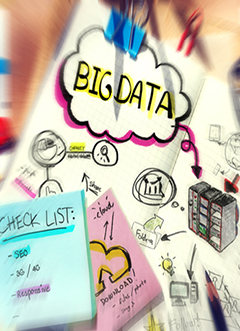– By Mike Fish
Big Data is much talked about and poorly understood. Indeed it has often been likened to “teenage sex – everyone thinks everyone else is doing it, but few actually are”. But in 2015, it really is time to stop dreaming and start doing.
Fuelled by tech firms looking to refresh and extend their markets and driven by technical solutions looking for problems, it is hardly surprising that the business justification for Big Data has been drowned out. This is extraordinarily short term, since there is no doubt that Big Data can bring real value to businesses, whatever their sector.
The problem is just that this is not a technology wave – it’s an opportunity for business transformation enabled by technology. And this is the reason why using the language of technology is not convincing for business leaders who want to know how it can help their bottom line.
There are five broad types of business applications that are directly enabled by Big Data.
 1. Revenue generation and business model development, particularly in retail and consumer packaged goods where there is direct or indirect interaction with large consumer markets. Marketing uses social media information, both content and relationship, to move from sampling to full dataset analysis; from demographic segments to markets-of-one, and from longer-term trending of historical data to near real-time reaction to emerging events. Prediction of customer behaviours and of outcomes of proposed actions allows new business models to be created and tested, ultimately driving increased revenue.
1. Revenue generation and business model development, particularly in retail and consumer packaged goods where there is direct or indirect interaction with large consumer markets. Marketing uses social media information, both content and relationship, to move from sampling to full dataset analysis; from demographic segments to markets-of-one, and from longer-term trending of historical data to near real-time reaction to emerging events. Prediction of customer behaviours and of outcomes of proposed actions allows new business models to be created and tested, ultimately driving increased revenue.
For a real-world example, take Rapid Racking, a UK manufacturer of shelving and racking products. Their pre-data analytics approach was to send out a 160-page generic catalogues to millions of addresses, creating an unacceptably high acquisition cost. By using analytics software and current customer data, Rapid Racking created an algorithm, applied it to third-party data to predict the most promising prospects who then received smaller, customized catalogues. The result? Rapid Racking decreased acquisition costs by 47% while increasing revenue by 8%.
2. Cost containment in real-time becomes viable as monitoring – from cars or smartphones to fraud detection in financial transaction data and more – expands to include larger volumes of messages on ever-shorter timescales. Big Data analysis techniques to stream data “as it happens” have become the norm, enabling faster reaction to specific problems before they escalate into major situations.
3. Real-time forecasting becomes possible as utilities, such as water/electricity supply and telecommunications, move from measuring consumption on a macro- to a micro-scale using pervasive sensor technology. Value arises as consumption peaks and troughs can be predicted – and in some cases smoothed – by influencing consumer behaviour. Predictive maintenance now becomes a competitive weapon.
4. Tracking of physical items by manufacturers, producers and distributors. Everything from food items to household appliances and from parcel post to container shipping – through distribution, use and even disposal – drives deep optimisation of operational processes and enables improved customer experiences. People, as physical entities, are also subject to tracking – for business, social or national security reasons.
5. Reinventing business processes through innovative use of sensor-generated data offers the possibility of reconstructing entire industries. Car insurers, for example, can now set premiums based on actual behaviour rather than statistically averaged risk. The availability of individual genomic data and electronic medical records presents the medical and health insurance industries with significant opportunities, not to mention ethical dilemmas.
What is conventionally described as ‘Big Data’ can include the data that businesses use today in their day-to-day operations, such as customer records, payment transactions, stock and supply chain records and so on. These transactional systems are designed to ‘run’ your business, whereas analytical systems – including Business Intelligence (BI) – are designed to help ‘manage’ your business. However, most BI systems produce weekly or monthly reports and dashboards, and so are primarily a ‘rear-view mirror’ on the performance of the business.
Big Data goes further, looking at current (real-time) and future (predictive) behaviour and avoiding pre-judging what analyses will be required (no standard reports) – instead including discovery tools to explore new patterns and relationships. It also handles a wider variety of data types (not only structured records, but also unstructured data: from Twitter and Facebook posts to medical or CCTV images.
The ability of analytics to boost profits is real. For example, a European financial institution dramatically increased both the number and quality of segmented campaigns with sharply increased results. Combining its transaction data with demographic data, the financial institution was able to vastly improve its direct marketing. Sales from direct marketing grew from close to zero to 30% in consumer loans, 33% in overdraft protection purchases, and 60% in credit cards.
But using existing internal data does not provide the whole story. As part of our blue sky thinking with clients, we also consider what could be done to drive further business efficiencies. Perhaps credit-referencing data could be used to reduce customer default risk for example, or weather data used as an input to marketing campaigns for outdoor goods or ice cream. There are many examples of where external data can be combined with existing processes to create new value or efficiencies.
So “Big Data” is likely to be important for small and large businesses alike – but it needs to be harnessed for the benefit of the business as a whole, rather than being a new toy for the specialists.
 Mike Fish is Founder at BigData4Analytics, the UK’s leading specialist Management Consultants for Analytics. The firm works with leaders of businesses of all sizes – in retail, ecommerce, supply chain and financial services, using analytics for finance, operations, HR, marketing and social media. www.bigdata4analytics.com
Mike Fish is Founder at BigData4Analytics, the UK’s leading specialist Management Consultants for Analytics. The firm works with leaders of businesses of all sizes – in retail, ecommerce, supply chain and financial services, using analytics for finance, operations, HR, marketing and social media. www.bigdata4analytics.com
This article is adapted from Mike’s recently published article: “CEO Masterclass: Using Big Data as a competitive weapon”.
Image from shutterstock.com